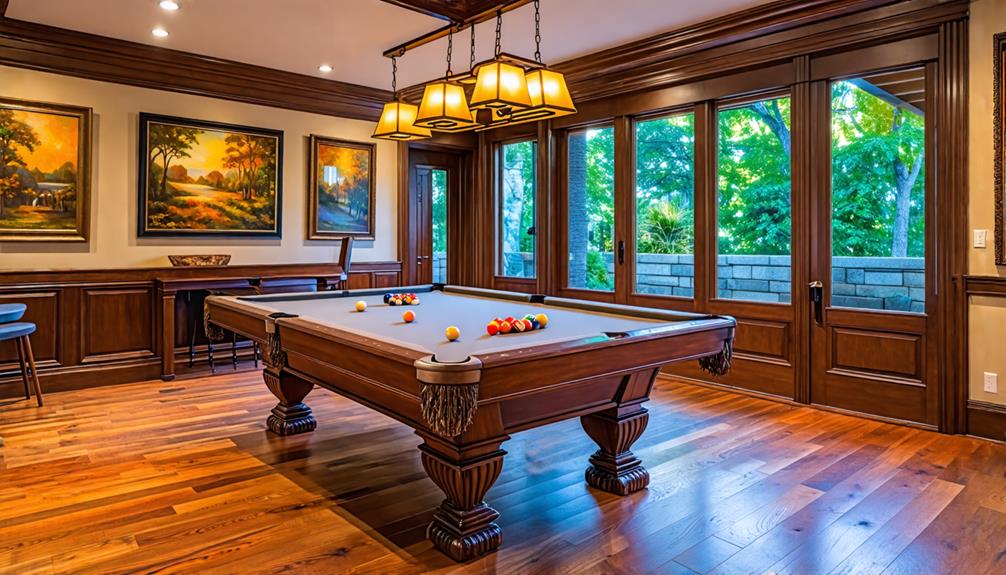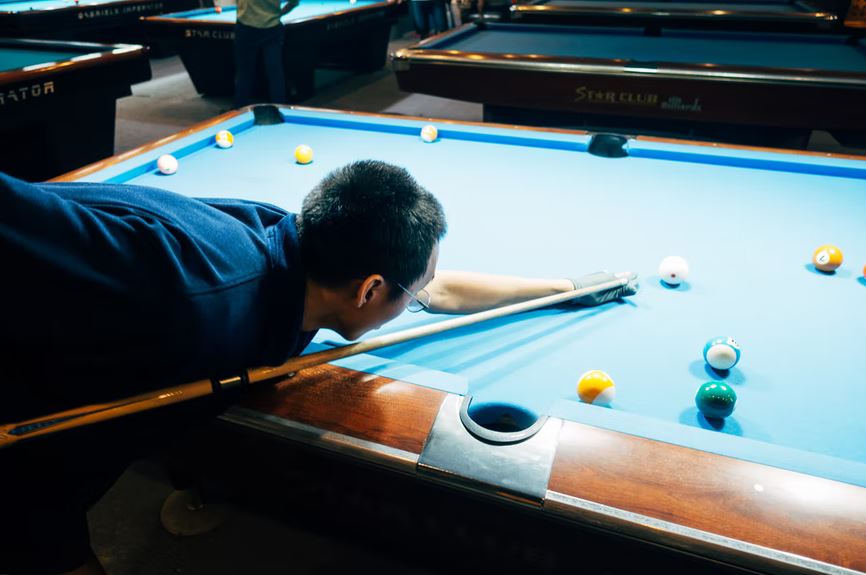The History of Pool and Billiards: A Fascinating Journey
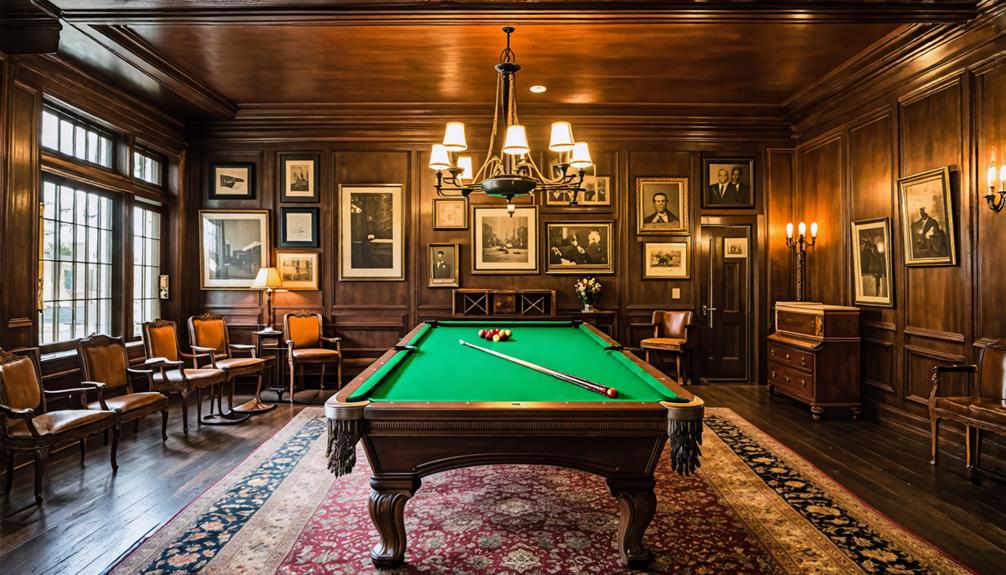
The history of pool and billiards dates back to 15th-century Europe, evolving from outdoor lawn games favored by the elite. As it transitioned into an indoor activity, various innovations, such as the development of the cue stick and specialized tables, played crucial roles. This transformation saw the game gain popularity among royalty and, eventually, in American culture. What factors contributed to its enduring legacy and widespread appeal? The answer lies in a complex interplay of social dynamics and technological advancements that have made the game a lasting favorite.
Origins of Billiards
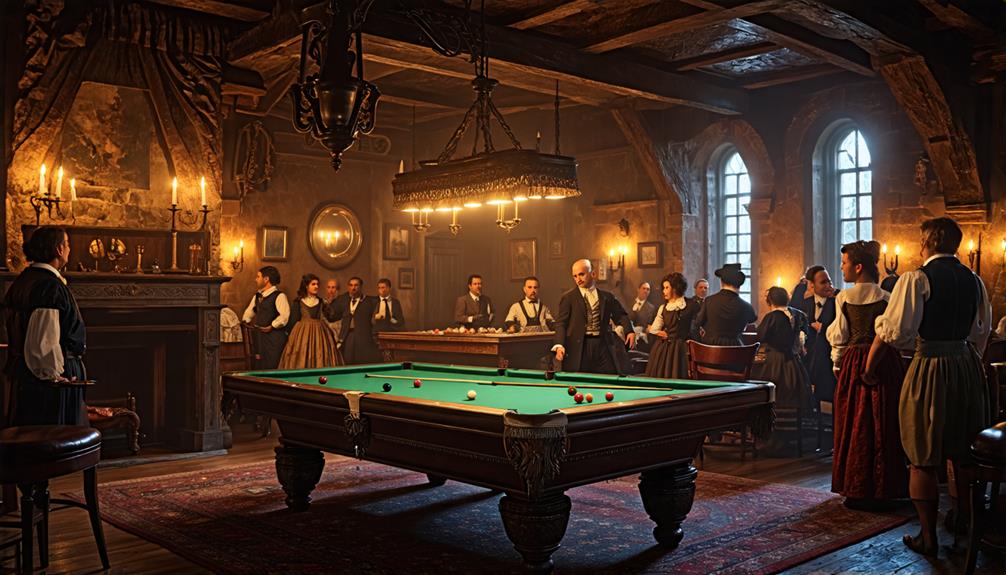
Billiards originated in 15th-century Europe, evolving from noble outdoor lawn games similar to croquet. The game quickly gained popularity among the aristocracy, offering a sophisticated pastime for the elite. The term 'billiard' comes from the French word 'billart,' referring to the mace used to strike balls in early versions of the game.
Billiards served not just as a game but also as a social activity, fostering connections among the nobility. The introduction of the cue stick in the late 17th century marked a significant turning point in gameplay, replacing the traditional mace and allowing for greater precision and control. King Louis XIV played a crucial role in elevating billiards' status and spreading its appeal throughout European courts. His enthusiasm for the game helped solidify its cultural significance among the aristocracy. From its humble beginnings on outdoor lawns to the refined tables of noble houses, billiards has a rich history that reflects both social dynamics and evolving gameplay.
Transition to Indoor Play
As billiards gained popularity among the elite, players transitioned the game indoors, leading to the creation of specialized wooden tables that enhanced gameplay. This shift allowed enthusiasts to enjoy billiards year-round, significantly boosting its appeal across Europe. The green cloth covering these tables was introduced to mimic the game's grassy origins, creating a familiar yet sophisticated environment.
The rise of indoor venues also led to the establishment of billiard halls, which became important social hubs. These spaces offered both leisure and competition, fostering a vibrant community of players. During this period, standardized table dimensions were also developed, marking a significant step in formalizing billiards gameplay.
The impact of this transition is summarized below:
| Aspect | Details |
|---|---|
| Play Environment | Shift from outdoor to indoor |
| Game Equipment | Specialized wooden tables |
| Social Spaces | Emergence of billiard halls |
| Gameplay Standardization | Development of standard table dimensions |
Through these changes, billiards solidified its status as a beloved pastime, attracting players from diverse backgrounds.
Evolution of Cue Sticks
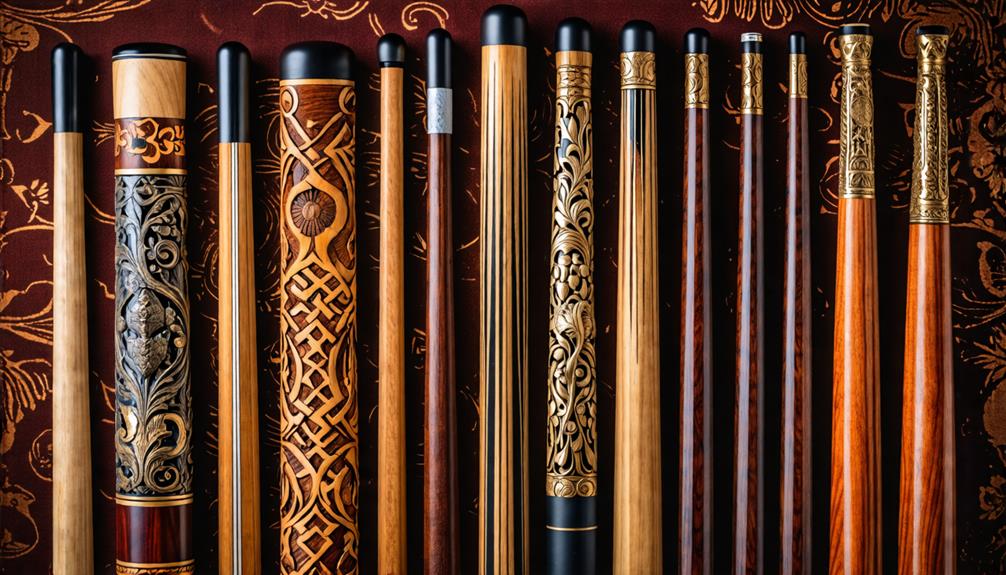
The evolution of cue sticks has significantly transformed billiards gameplay, moving from simple wooden rods to precision-crafted instruments that enhance players' skills. Initially, cue sticks were basic wooden tools used primarily for pushing balls. However, by the late 17th century, their design evolved to allow players to strike balls with greater accuracy. The term 'cue' is derived from the French word 'queue,' reflecting the elongated design essential for effective striking.
Over time, cue sticks transitioned from solid wood to advanced materials like fiberglass and graphite, enhancing both durability and performance. Modern innovations in cue tips, made from materials like leather and synthetic compounds, have further improved grip and control, allowing for more precise shots. Additionally, the development of specialized cue sizes and weights has enabled players to select equipment tailored to their playing style, enhancing comfort and skill level.
Popularity Among Royalty
Billiards has long been associated with royalty, gaining status and sophistication as kings and queens embraced the game. This royal endorsement significantly influenced its popularity among the elite, cementing billiards as a prestigious pastime.
Royal Patronage Influence
Billiards flourished among European royalty in the 17th century, thanks to influential patrons such as King Louis XIV, who not only owned a billiard table but also championed the game within aristocratic circles. This royal endorsement significantly increased the popularity of billiards across European royal courts. Nobles and aristocrats adopted billiards as a leisure activity, showcasing their status and sophistication.
The game's allure was further enhanced as it became a fashionable pastime in England, captivating figures like Henry VIII. Billiards transitioned from outdoor games to opulent indoor billiard rooms, highlighting its appeal among the affluent. It wasn't just a game; it became a symbol of refined taste and social connection.
As billiards spread throughout Europe, it became intertwined with elite social gatherings, fostering a communal atmosphere that elevated its status. Shakespeare's mention of billiards in 'Antony and Cleopatra' underscores its cultural significance during the Renaissance. Engaging in billiards was more than just playing; it was participating in a social ritual, solidifying its place as a prestigious pastime among royalty and the upper classes.
Billiards as Status Symbol
In the 17th century, billiards emerged as a prestigious status symbol among European royalty, captivating the elite with its elegance and social allure. King Louis XIV of France famously commissioned luxurious billiard tables for his court, solidifying the game's association with sophistication and wealth.
Billiards became more than just a pastime; it became an essential part of royal gatherings, showcasing the leisure and affluence of the aristocracy.
- Billiards marked wealth, attracting the elite to its tables.
- Shakespeare's mention of billiards in 'Antony and Cleopatra' highlights its cultural significance.
Billiards in America
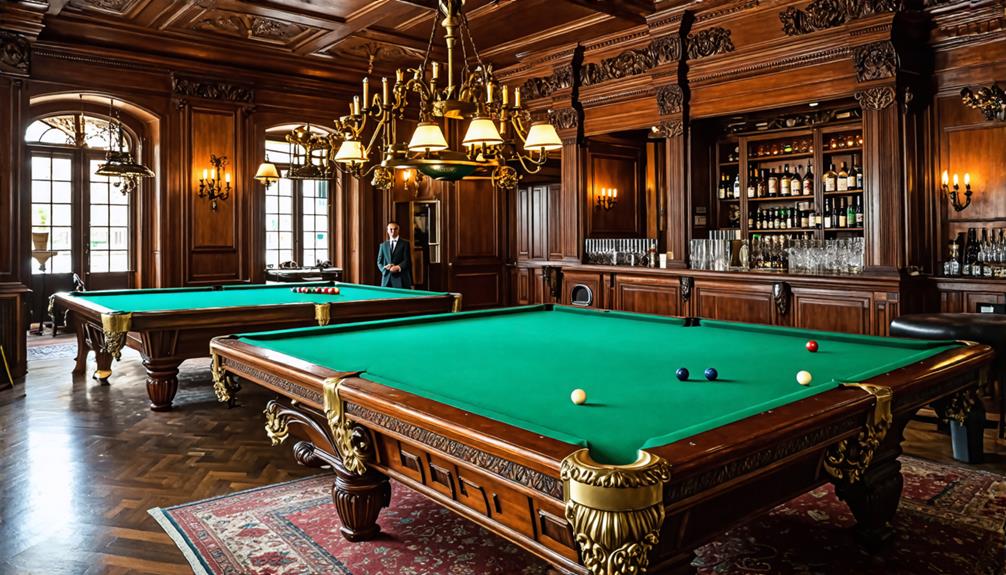
Billiards made its mark in America during the 18th century, quickly becoming a favorite among influential figures. As pool halls sprang up in the 19th century, the game evolved into a popular pastime for everyone, transcending social classes. Notable players shaped its culture and helped cement billiards as a staple of American recreation.
Early American Adoption
Billiards arrived in America during the 18th century and swiftly gained the attention of influential figures like George Washington and Benjamin Franklin. They embraced the game for both leisure and social interaction. These early enthusiasts played a crucial role in establishing billiards' growing popularity across the nation.
By the late 18th century, billiards had evolved into a symbol of social status and sophistication. Key developments in the game included:
- The establishment of billiard halls, which offered venues for playing and socializing.
- The introduction of pocketed tables, transforming gameplay and attracting more players.
During this period, billiards became an integral part of American culture, blending leisure, competition, and community engagement. The enthusiasm of early adopters like Washington and Franklin helped ignite a passion for the game, shaping the vibrant billiards scene we recognize today.
Growth of Pool Halls
Pool halls emerged as vibrant social hubs in America during the 19th century, where individuals gathered for friendly competition and camaraderie. The popularity of billiards soared as these venues attracted a diverse range of players, from casual enthusiasts to serious competitors.
By the late 19th century, billiard halls had evolved beyond mere entertainment; they became centers for community interaction and a sense of belonging. The advent of mass-produced pool tables made the game more accessible, leading to a rapid increase in local pool rooms across the country.
Upon entering a pool hall, one would often witness lively matches, laughter, and occasionally, a friendly wager. Betting on billiards began to grow, drawing inspiration from horse racing and embedding the game deeper into American culture. With the endorsement of influential figures like George Washington and Benjamin Franklin, billiards had already secured its place in society. Pool halls subsequently became gathering spots where friendships were forged and rivalries ignited. This growth not only increased the game's popularity but also solidified billiards as an integral part of American social life, evolving into a cherished pastime for generations.
Influence of Notable Players
Notable players like Willie Mosconi, Minnesota Fats, and Efren Reyes have profoundly shaped American billiards, each leaving a lasting impact on the game's popularity and competitive spirit. Their unique styles and larger-than-life personalities have drawn many into the sport.
- Willie Mosconi, known as 'Mr. Pocket Billiards,' set numerous records and won the World Straight Pool Championship 15 times, showcasing unparalleled skill and precision.
- Minnesota Fats, with his charismatic showmanship, gained fame in the 1950s, turning pool into a spectacle through exhibitions and television appearances.
- Efren Reyes, dubbed 'The Magician,' transformed American pool with his creative shot-making and strategic gameplay, winning multiple world championships.
The influence of notable players like Mosconi and Fats is undeniable. Their 1978 match highlighted the contrast between Mosconi's accuracy and Fats' flamboyant flair, drawing national attention and inspiring countless players. Each of these legends not only enhanced the sport but also fostered a competitive spirit that continues to drive aspiring players today. Their legacies endure, shaping the future of billiards in America.
Technological Advancements
Technological advancements have revolutionized billiards, enhancing both performance and player experience through innovative materials and smart features. Phenolic resin has replaced ivory for billiard balls, offering superior durability and consistent play. Cue sticks have transitioned from basic wood to advanced materials like graphite and fiberglass, providing enhanced precision and control.
Billiard tables have similarly evolved. Slate is now the preferred material for table beds, significantly increasing stability, while synthetic materials have improved cushion performance, resulting in better ball behavior. These changes are noticeable during play. Additionally, modern pool tables now incorporate smart features such as sensors and analytics, transforming gameplay. These advancements enable players to track performance and improve skills more effectively. Online gaming platforms and augmented reality interfaces make billiards more immersive and accessible, attracting new players. The game continues to evolve, making each session more engaging and dynamic.
Cultural Significance of Pool
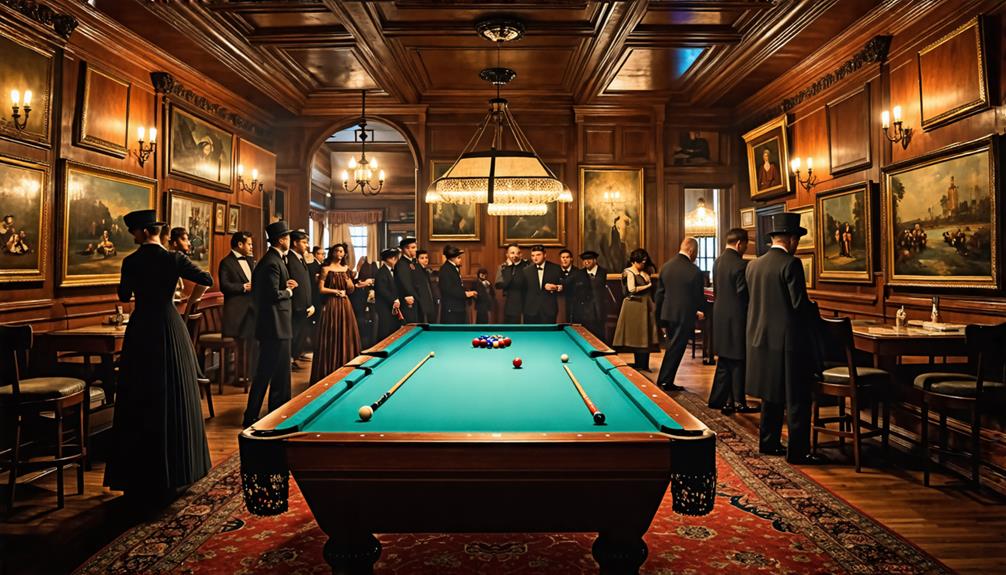
The evolution of billiards hasn't only transformed gameplay through technological advancements but also cemented its cultural significance as a social activity that fosters connection and community throughout history. From its beginnings as a royal pastime to its rise as a popular sport, billiards has created spaces where people gather.
Billiards is embedded in numerous aspects of culture, making it an essential part of social activities. Here are a few ways it connects communities:
- Billiard Halls: These venues emerged as popular social hubs in the 19th century, offering a relaxed atmosphere for players to bond and socialize.
- Cultural Events: Tournaments such as the World Snooker Championship underscore billiards' status as a globally recognized sport, attracting diverse audiences and fostering communal engagement.
Through these elements, billiards reinforces community connections. It's more than just a game; it's a shared experience that brings people together, transcending social barriers and enriching cultural landscapes.
Conclusion
Exploring the rich history of pool and billiards reveals how this captivating game transitioned from outdoor lawns to sophisticated indoor settings. The journey through time showcases its aristocratic origins, the development of cue sticks, and its widespread popularity in America. Today, billiards is more than just a pastime; it's a cultural cornerstone that brings people together, nurtures friendships, and evolves with technological advancements, ensuring its enduring presence in social gatherings for generations to come.
